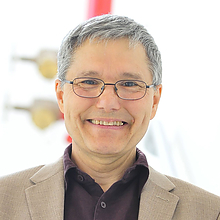Dana Nau

Dana Nau is a professor in the Department of Computer Science and the Institute for Systems Research.
His research focuses on artificial intelligence (AI), especially in the areas of game theory and AI planning. Nau also co-directs the Laboratory for Computational Cultural Dynamics.
He is a fellow of AAAI, and has received dozens of other awards and honors.
Some of Nau's best-known accomplishments include (1) discovering game-tree pathology, which has led to subsequent research by dozens of other researchers over the past three decades; (2) co-authoring the strategy-generation algorithm that enabled the Bridge Baron program to win the 1997 world championship of computer bridge; (3) leading the development of the SHOP and SHOP2 automated-planning systems, which have been used in many hundreds of projects in industry, government, and academia; (4) co-authoring a widely used graduate-level textbook, "Automated Planning: Theory and Practice."
He received his doctorate in computer science from Duke University in 1979.
Publications
1997
1997. Automated manufacturability analysis: A survey. Research in Engineering Design. 9(3):168-190.
1997. Towards multiprocessor feature recognition. Computer-Aided Design. 29(1):37-51.
1996
1996. Generating redesign suggestions to reduce setup cost: a step towards automated redesign. Computer-Aided Design. 28(10):763-782.
1995
1995. Automated Manufacturability Analysis: A Survey. ISR; TR 1995-14
1995. Manufacturing feature instances: which ones to recognize? :141-152.
1995. Estimation of setup time for machined parts: accounting for work-holding constraints using a vise. COMPUTERS IN ENGINEERING. :619-632.
1995. Current Trends and Future Challenges in Automated Manufacturability Analysis. ISR; TR 1995-16
1995. Systematic approach to analysing the manufacturability of machined parts. Computer-Aided Design. 27(5):323-342.
1995. Extracting alternative machining features: An algorithmic approach. Research in Engineering Design. 7(3):173-192.
1994
1994. Feature Recognition for Manufacturability Analysis. ISR; TR 1994-10
1994. An Application of Distributed Solid Modeling: Feature Recognition. ISR; TR 1994-82
1994. Integrating DFM with CAD through Design Critiquing. Concurrent EngineeringConcurrent Engineering. 2(2):85-95.
1994. Building MRSEV models for CAM applications. Advances in Engineering Software. 20(2–3):121-139.
1993
1993. A Systematic Approach for Analyzing the Manufacturability of Machined Parts. ISR; TR 1993-76
1993. Interpreting Product Designs for Manufacturability Evaluation. ISR; TR 1993-45
1993. Development of machining alternatives, based on MRSEVs. Computers in Engineering. :47-47.
1993. Evaluating product machinability for concurrent engineering. Concurrent Engineering: Contemporary Issues and Modern Design Tools. :264-279.
1993. Concurrent evaluation of machinability during product design. Computer. 26(1):61-63.
1993. Estimation of Achievable Tolerances. ISR; TR 1993-44
1992
1992. General of Machining Alternatives for Machinability Evaluation. ISR; TR 1992-106
1992. Generation and Evaluation of Alternative Operation. ISR; TR 1992-20
1992. Generation of Machining Alternatives for Machinability Evaluation. ISR; TR 1992-106
1986
1986. Relationships between deductive and abductive inference in knowledge-based diagnostic problem solving. Expert Database Systems: Proceedings of the First International Workshop. New York: Benjamin Cummings.
1986. A comparative analysis of methods for expert systems. International journal of man-machine studies. 24(5):475-499.
1985
1985. A formal model of diagnostic inference, II. Algorithmic solution and application. Information Sciences. 37(1-3):257-285.
1985. Answer Justification in Diagnostic Expert Systems-Part II: Supporting Plausible Justifications. Biomedical Engineering, IEEE Transactions on. (4):268-272.
1985. A formal model of abductive inference. Information Sciences. 37:227-285.
1985. Answer justification in abductive expert systems for diagnostic problem solving. IEEE Transactions on Biomedical Engineering.
1984
1984. An abductive non-monotonic logic. Workshop on Nonmonotonic Reasoning.
1983
1983. A New Inference Method for Frame-based Expert System. Proceedings of the National Conference on Artificial Intelligence. :333-337.
1983. Diagnostic expert systems based on a set covering model. International Journal of Man-Machine Studies. 19(5):437-460.
1983. S., Wang. PY, Diagnostic Expert Systems Based on a Set Covering Model. International Journal on Man-Machine studies. 19:437–46O-437–46O.
